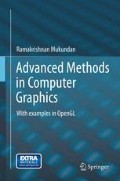Overview
In computer graphics applications, three-dimensional models are almost always represented using polygonal meshes. A mesh in its simplest form consists of a set of vertices, polygons, and optionally a number of additional vertex and polygonal attributes. The complexity of a mesh can vary from low to very high depending on requirements such as rendering quality, speed and resolution. A wide spectrum of mesh processing algorithms is used by graphics and game developers for a variety of applications such as generating, simplifying, smoothing, remapping and transforming meshes. Several types of data structures and file formats are also used to store mesh data.
This chapter discusses the geometrical and topological aspects related to three-dimensional meshes and their processing. It also presents important data structures and algorithms used for operations such as mesh simplification, mesh subdivision, planar embedding, and polygon triangulation.
Access this chapter
Tax calculation will be finalised at checkout
Purchases are for personal use only
References
Baumgart, B. (1972). Winged edge polyhedron representation (C. S. D. Stanford Artificial Intelligence Project, Trans.): Stanford University.
Bennis, C., Vezien, J.-M., & Inglesias, G. (1991). Piecewise surface flattening for non-distorted texture mapping. SIGGRAPH Computer Graphics, 25(4), 237–246.
Botsch, M. (2010). Polygon mesh processing. Natick: A K Peters.
Catmull, E., & Clark, J. (1978, September). Recursively generated B-spline surfaces on arbitrary topological meshes. Computer Aided Design, 10, 350–355.
De Loera, J. A., Rambau, J., & Santos, F. (2010). Triangulations: Structures for algorithms and applications. Heidelberg: Springer.
Edelsbrunner, H. (2001). Geometry and topology for mesh generation. Cambridge: Cambridge University Press.
Floater, M., & Hormann, K. (2005). Surface parameterization: A tutorial and survey. In Advances in multiresolution for geometric modelling (pp. 157–186). Heidelberg: Springer.
Foley, J. D. (1996). Computer graphics: Principles and practice (2nd ed. in C.). Reading/Wokingham: Addison-Wesley.
Garland, M. (1999). Quadric-based polynomial surface simplification. Ph.D., Carnegie Mellon, Pittsburgh (CMU-CS-99-105).
Kettner, L. (1998). Designing a data structure for polyhedral surfaces. In: Proceedings of the fourteenth annual symposium on Computational geometry, Minneapolis, Minnesota, United States.
Kobbelt, L. (2000). Root3-subdivision. In: Proceedings of the 27th annual conference on Computer graphics and interactive techniques.
Loop, C. (1987). Smooth subdivision surfaces based on triangles. M.Sc., The University of Utah, Utah.
Melax, S. (1998, November). A simple, fast and effective polygon reduction algorithm. Game Developer, 44–49.
Nielsen, F. (2005). Visual computing: Geometry, graphics, and vision. Hingham/London: Charles River Media/Transatlantic, (distributor).
Saba, S., Yavneh, I., Gotsman, C., & Sheffer, A. (2005). Practical spherical embedding of manifold triangle meshes. In: Proceedings of the international conference on shape modeling and applications 2005, Boston
Schroeder, W. J., Zarge, J. A., & Lorensen, W. E. (1992). Decimation of triangle meshes. SIGGRAPH Computer Graphics, 26(2), 65–70.
Sheffer, A., Praun, E., & Rose, K. (2006). Mesh parameterization methods and their applications. Foundations and Trends in Computer Graphics and Vision, 2(2), 105–171.
Shirley, P., & Ashikhmin, M. (2007). Fundamentals of computer graphics (2nd ed.). Wellesley/London: AK Peters.
Zorin, D. (2006). Subdivision of arbitrary meshes: Algorithms and theory (Institute of Mathematical Sciences lecture notes series). Singapore: World Scientific.
Author information
Authors and Affiliations
Corresponding author
Rights and permissions
Copyright information
© 2012 Springer-Verlag London Limited
About this chapter
Cite this chapter
Mukundan, R. (2012). Mesh Processing. In: Advanced Methods in Computer Graphics. Springer, London. https://doi.org/10.1007/978-1-4471-2340-8_8
Download citation
DOI: https://doi.org/10.1007/978-1-4471-2340-8_8
Published:
Publisher Name: Springer, London
Print ISBN: 978-1-4471-2339-2
Online ISBN: 978-1-4471-2340-8
eBook Packages: Computer ScienceComputer Science (R0)

